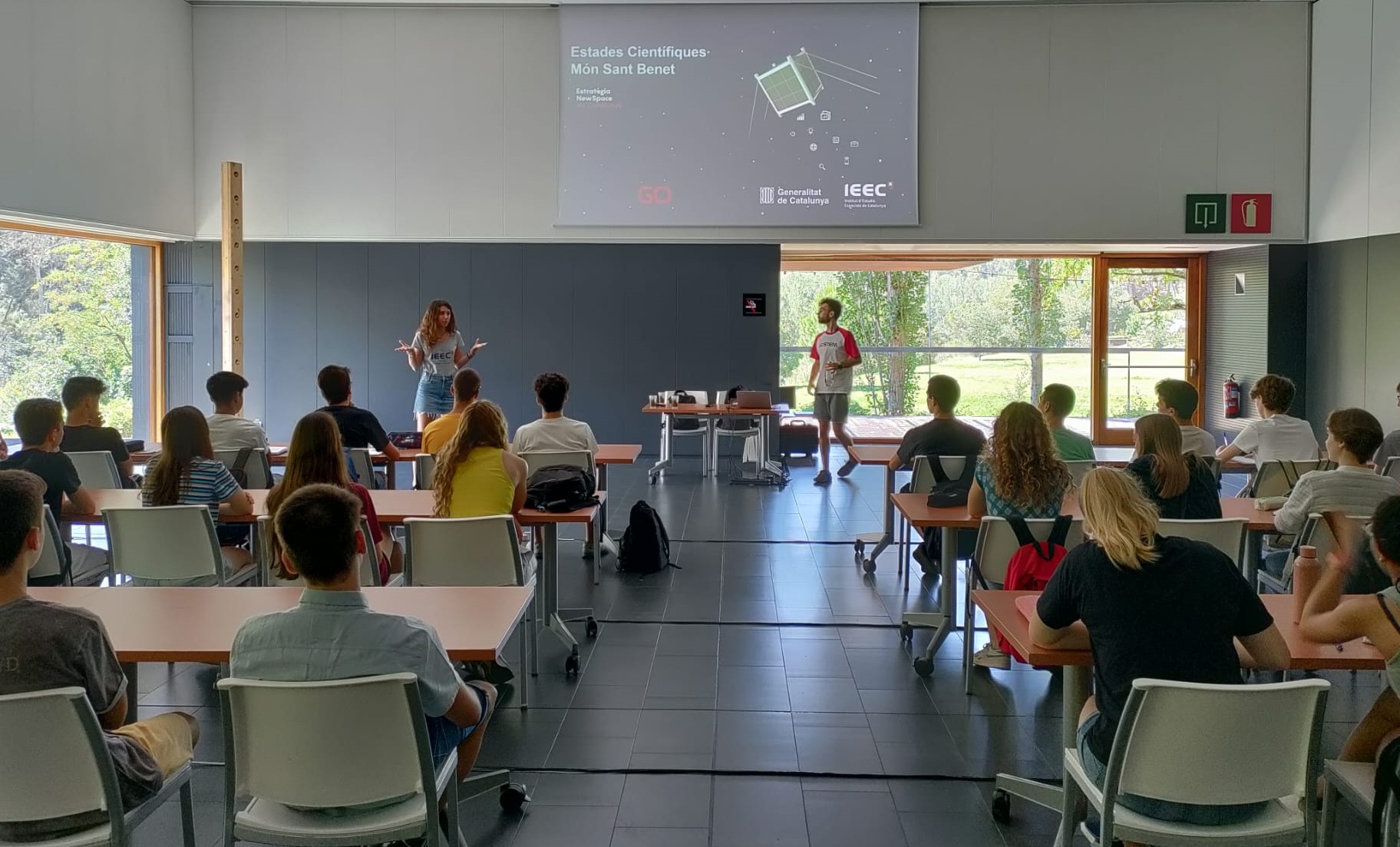Around fifty youths conquer space with the Scientific Stays of La Pedrera Foundation

The Catalunya La Pedrera Foundation, through Science Academy, and with the collaboration of the IEEC, GOSTEM and the Government of Catalonia, stimulates scientific vocations and motivation for research to train the best scientists of the future
From 2 to 7 July, the Catalunya La Pedrera Foundation brought 45 young people aged between 15 and 17 with an interest in aerospace engineering to Món Sant Benet, in collaboration with the Institute of Space Studies of Catalonia (IEEC — Institut d'Estudis Espacials de Catalunya), GOSTEM and the Government of Catalonia.
The ‘Scientific Stay – NewSpace: we take off with aerospace engineering’ allowed the secondary education and high school students to learn, design, build, test, launch and operate two small satellites on technological and scientific missions. The scientific team accompanied the students during the whole immersive experience, combining theoretical sessions, space anecdotes and explanations of practical cases.
This programme has been made possible thanks to the collaboration of the Catalunya La Pedrera Foundation with the IEEC, within the framework of the objectives of the Talent and Society programme of the NewSpace Strategy of Catalonia promoted by the Government of Catalonia. In particular, Anna Ruiz, programme manager at the IEEC, accompanied the teenagers throughout the sessions.
The scientific stays are unique programmes that offer an immersive week with the collaboration of leading professionals in the field of the stay.
A week of aerospace engineering
During the Scientific Stays – NewSpace, held at the cultural space Món Sant Benet (Bages, Catalonia), participants had the opportunity to immerse themselves in the field of space and acquire practical experience in the design and execution of space missions. The programme covered several important aspects in this area.
Firstly, students were provided with a detailed overview of the Talent Programme of the NewSpace Strategy of Catalonia. This programme aims to provide students with knowledge and tools related to space science and technology, with the aim of encouraging the generation and retention of talent in this field. A global vision of the NewSpace field and of the key subsystems for a space mission with a Cubesat-type nanosatellite was offered.


Left: The participants were visited by Juan de Dalmau, former president of the International Space University.
Right: Students prepare the High Altitude Balloon for their mission.
Subsequently, space history and the basic concepts underpinning this unique exploration were discussed. Relevant space missions were reviewed and the different systems required for space travel were also addressed. In addition, the teams started to design a high-altitude mission they would carry out with a High Altitude Balloon (HAB).
During the programme, the participants faced the challenges of launching an object into the stratosphere. They explored the different subsystems needed for a successful mission and carried out integrations and designs for the construction of the probe.
Time was devoted to the probe construction and performing simulations and flight tests to ensure optimal operation of all subsystems. The in-flight recovery system, the on-board computer and the camera were verified to ensure their performance during the flight.

The students did not miss a single detail of the launch of the probe.
Finally, the long-awaited launch day arrived. The participants moved to the designated area to lift the balloon. After recovery from the HAB, they returned to their stations to analyse the collected data.
On the final day of the programme, the participants studied the results obtained and drew conclusions from the challenges and experiences. Each team presented their projects and the collected data, in a scientific format, providing a comprehensive view of their work.
The Scientific Stays – NewSpace offered the young participants an unparalleled opportunity to delve deeper into the field of space and gain practical experience in the design and execution of space missions.
Main Image
Caption: Welcome presentation to the participants.
Credits: IEEC
Links
– IEEC
– Catalunya La Pedrera Foundation
– GOSTEM
– NewSpace Strategy of Catalonia
More information
The Institute of Space Studies of Catalonia (IEEC — Institut d’Estudis Espacials de Catalunya) promotes and coordinates space research and technology development in Catalonia for the benefit of society. IEEC fosters collaborations both locally and worldwide and is an efficient agent of knowledge, innovation and technology transfer. As a result of more than 25 years of high-quality research, done in collaboration with major international organisations, IEEC ranks among the best international research centres, focusing on areas such as: astrophysics, cosmology, planetary science, and Earth Observation. IEEC’s engineering division develops instrumentation for ground- and space-based projects, and has extensive experience in working with private or public organisations from the aerospace and other innovation sectors.
IEEC is a private non-profit foundation, governed by a Board of Trustees composed of Generalitat de Catalunya and four other institutions that each have a research unit, which together constitute the core of IEEC R&D activity: the Universitat de Barcelona (UB) with the research unit ICCUB — Institute of Cosmos Sciences; the Universitat Autònoma de Barcelona (UAB) with the research unit CERES — Center of Space Studies and Research; the Universitat Politècnica de Catalunya · BarcelonaTech (UPC) with the research unit CTE — Research Group in Space Sciences and Technologies; the Spanish Research Council (CSIC) with the research unit ICE — Institute of Space Sciences. The IEEC is a CERCA (Centres de Recerca de Catalunya) centre.
Contacts
IEEC Communication Office
Barcelona, Spain
E-mail: comunicacio@ieec.cat
